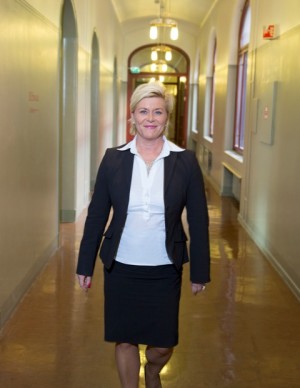Finance Minister Siv Jensen was offering more state funding for social welfare programs as she rolled out the government’s revised state budget on Tuesday. The extra money was widely viewed as an attempt to silence the government’s critics, while Jensen herself claimed that it simply was important to maintain key state and local services.

Without the extra billions of state kroner that Jensen was handing over, the local governments that administer everything from day care centers to nursing homes may well have had to cut back on social services. They now stand to get the single biggest chunk of the additional funding allocated in the revised state budget that reassesses needs and economic factors at mid-year.
Jensen had been under pressure to deliver some financial relief. Even many mayors from her own conservative Progress Party had demanded additional state funds to offset a decline in local tax revenues as Norway’s economy slows down. Several had threatened welfare cutbacks if they didn’t get more money, and that would not have been popular in advance of municipal elections this fall.
Jensen conceded on state broadcaster NRK’s national radio debate program Tuesday morning that a rise in unemployment and the country’s economic slowdown following the reduction in oil prices fueled the local governments’ need for some compensation. She refused to agree that some of the government’s tax-cutting last year created a shortfall that now needs to be corrected. She contended instead that her offer of new funds was simply part of “an overall evaluation” of Norway’s economic situation, which has changed since her initial state budget was presented last fall.
Long list of additional appropriations
Norway’s local governments will get an additional NOK 1.1 billion (USD 150 million), which they can spend as they see fit. In other proposed allocations, Jensen and Prime Minister Erna Solberg are also offering NOK 106 million to finance 64 programs aimed at helping children in relatively low-income families in Norway. The minister in charge of local governments, Jan Tore Sanner, told newspaper Dagsavisen on Tuesday that the government will also increase rental housing subsidy by NOK 111.1 million, to NOK 813.5 million.
Another NOK 100 million has been earmarked for anti-terror programs plus NOK 40 million to offset higher costs in local police districts caused by heightened security measures. As previously announced, an initial NOK 3 million has been allocated for a new “animal police” force to crack down on criminal abuse and negligence of animals. The so-called dyrepoliti (animal police) pilot program will start up this fall.
The government is also increasing foreign aid to Syrian refugees by another NOK 250 million, to NOK 1 billion, plus tripling the number of ill and injured refugees that Norway will accept, from 20 to 60. The government remains, meanwhile, under pressure from a majority in Parliament to accept 10,000 additional Syrian refugees. Jensen wouldn’t answer whether there’s room in her revised budget to fund acceptance of more refugees if the government finds itself forced to compromise and allow at least a few thousand. Others have said the refugee issue has been removed from budget negotiations and will be handled separately, starting next week.
Attempt to restore harmony
The revised budget is clearly aimed at restoring harmony with the government’s support parties, the Liberals and Christian Democrats, both of which have threatened to withdraw their government cooperation unless they get more backing for their own demands. Both also realize, however, that Norway’s economic situation has changed, and that it’s important to be prudent with state funding.
Despite her abhorrence of adding or raising taxes, Jensen is proposing a slight increase in the electricity tax (el-avgiften), or 0.5 percent, to help offset the loss of last fall’s highly disputed new tax on plastic bags. It was eventually scrapped but that created a revenue shortfall that the higher electricity tax can help fill. With electricity rates low and energy consumption falling, the higher tax was not expected to raise much dissent.
newsinenglish.no/Nina Berglund

